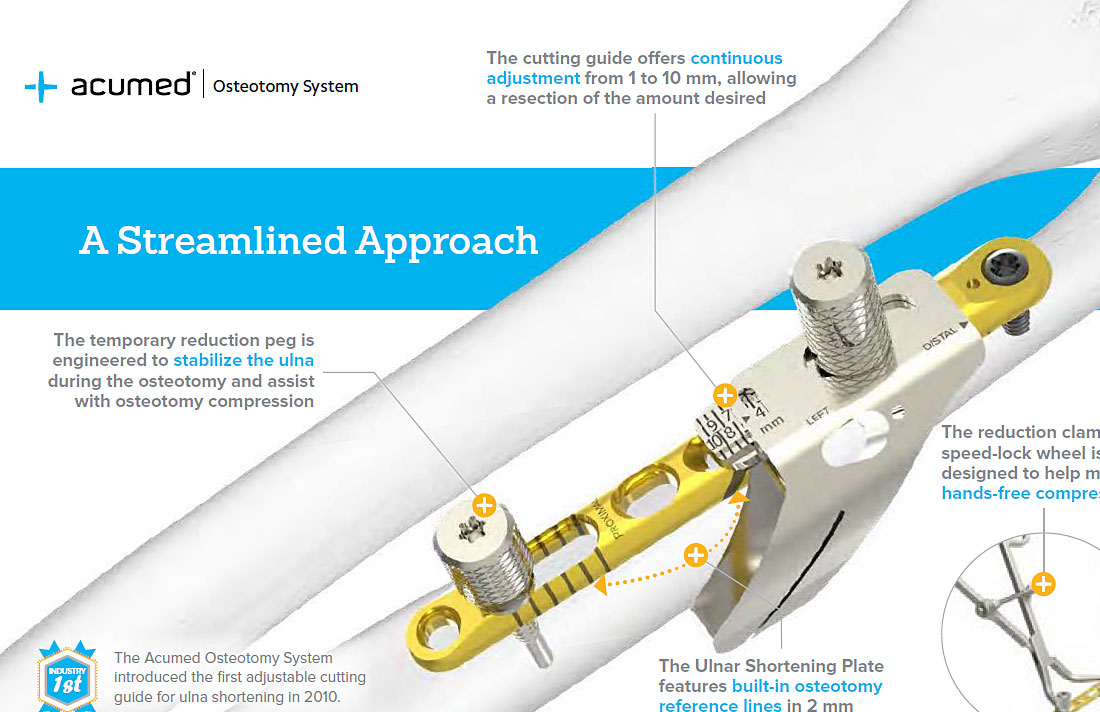Messaging Guide
Acutrak 2® Headless Compression Screw System
Evidence
Why This Matters
This study demonstrates that Acutrak 2 maintained greater compression than the DePuy Synthes screw in testing.
Publication Excerpt
The Headless Compression Solution for the Hand and Wrist
The Acutrak 2 Headless Compression Screw system is available in six different families for a total of 68 different screws to address a variety of hand and wrist applications.
Scaphoid Fixation
A study has demonstrated higher peak compression and significantly greater final force across a static simulated scaphoid fracture compared to a competitor.1
Fracture Location Flexibility
The Acutrak fully threaded continuously variable thread pitch feature allows a fracture site to lie almost anywhere along the length of the screw.
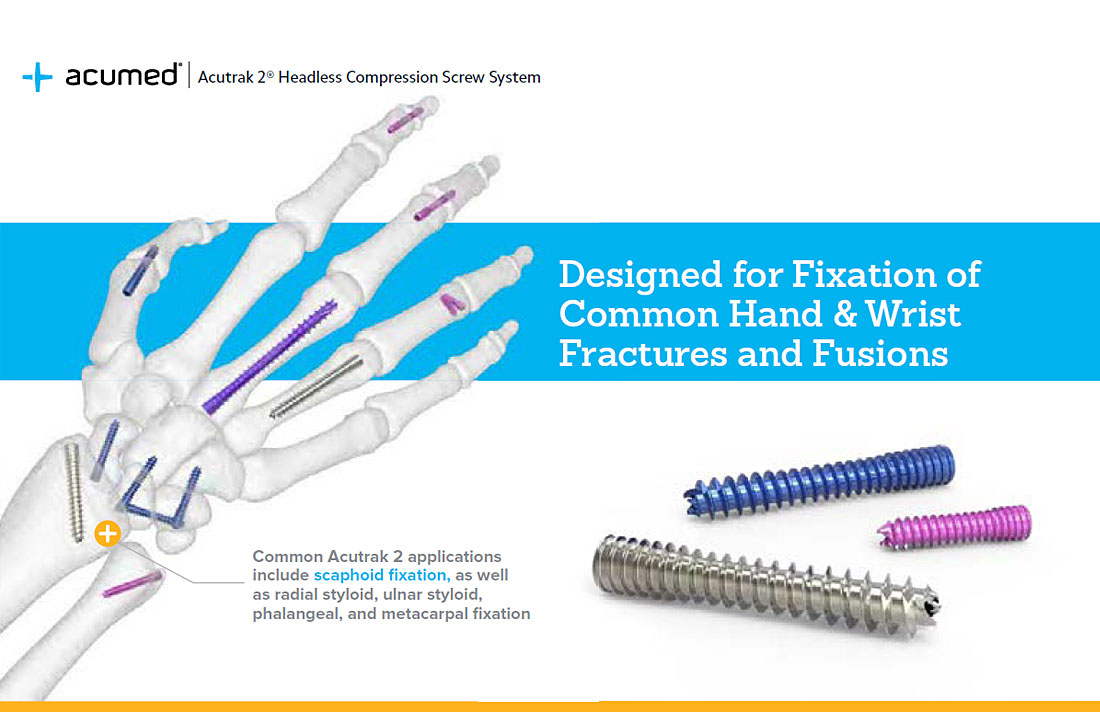
1. Grewal R, Assini J, Sauder D, Ferreira L, Johnson J, Faber K. A comparison of two headless compression screws for operative treatment of scaphoid fractures. J Orthop Surg Res. 2011;6:27.
Hand Fracture System
Evidence
Why This Matters
Acumed is one of the few companies to oer a specialized plate designed specifically for fifth metacarpal neck fractures, commonly referred to as “boxer” fractures.
Publication Excerpt
Comprehensive System
The system includes customizable Variable Angle Locking Plates, Small Bone External Fixator, Small Bone Distractor, and partially threaded lag screws.
Specialized Plates
Rolando Fracture Hook, Metacarpal Neck Fracture, Avulsion Hook, Curved Medial/Lateral, and Rotational Correction plates.
Versatile Screw-and- Plate System
The system was the first in the industry to allow multiple Hand Fracture System screw diameters in every hole of every plate in the system.
Specialized Instruments
Specialized instruments in the system include an osteotomy cutting guide, the SaveLock Compression Sleeve, unique clamps and forceps, and a plate cutter.
Lag Screws
The partially threaded Hexalobe Lag Screws do not require overdrilling of the near cortex to gain compression and can also be used as nonlocking screws in the slots of the plates.
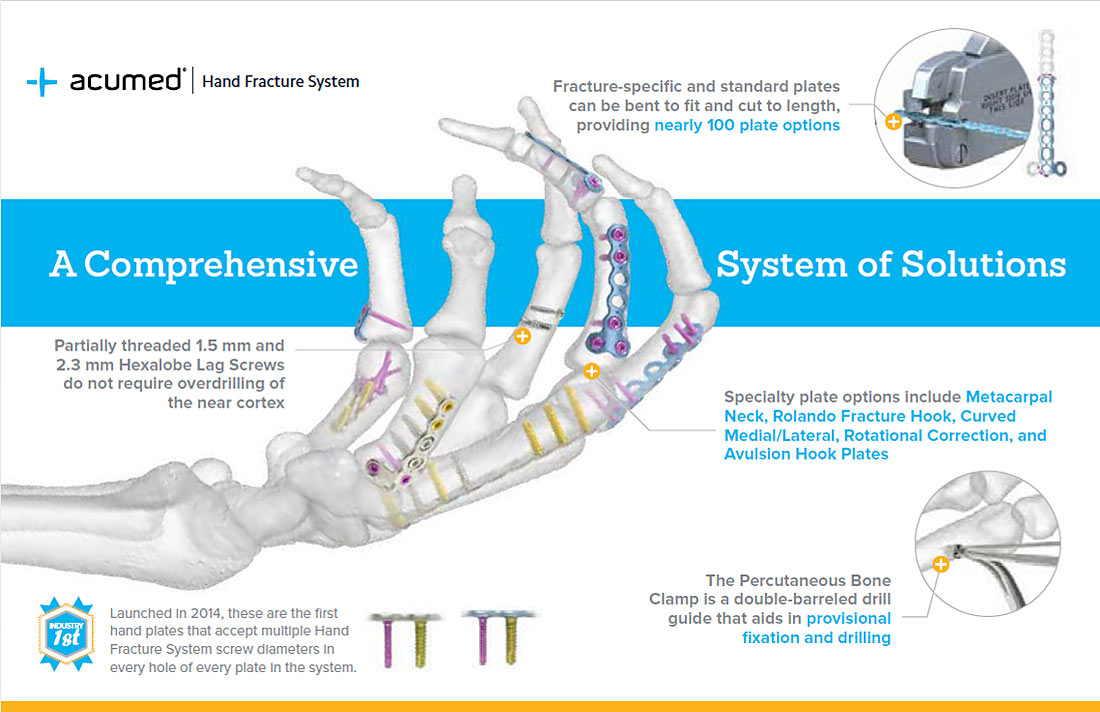
Small Bone External Fixation System
Evidence
Case Study - Marc J. Richard, MD
Post-amputation of his thumb, a 38-year-old male opted for metacarpal lengthening with the Acumed Small Bone Distractor to create a thumb that could allow pinch and grasp.
Publication Excerpt
A Pair of Solutions for External Fixation
Designed for the temporary stabilization of the metacarpals and phalanges, the system combines a fixator that aids in reduction and compression with a device designed to maintain distraction forces during healing.
Small Bone Distractor - Lengthening Treatment
The device provides distraction lengthening of the metacarpals, metatarsals, and phalanges as part of treatment for fractures, fusions, and osteotomies.
Small Bone External Fixator - Modular Design
K-wire pairs can be placed in any plane between medial/dorsal/lateral, while the rod clamps rotate to match wire placement.
Small Bone External Fixator - Rod Type Choice
Threaded stainless steel or carbon fiber rods oer versatility when building the fixator frame.
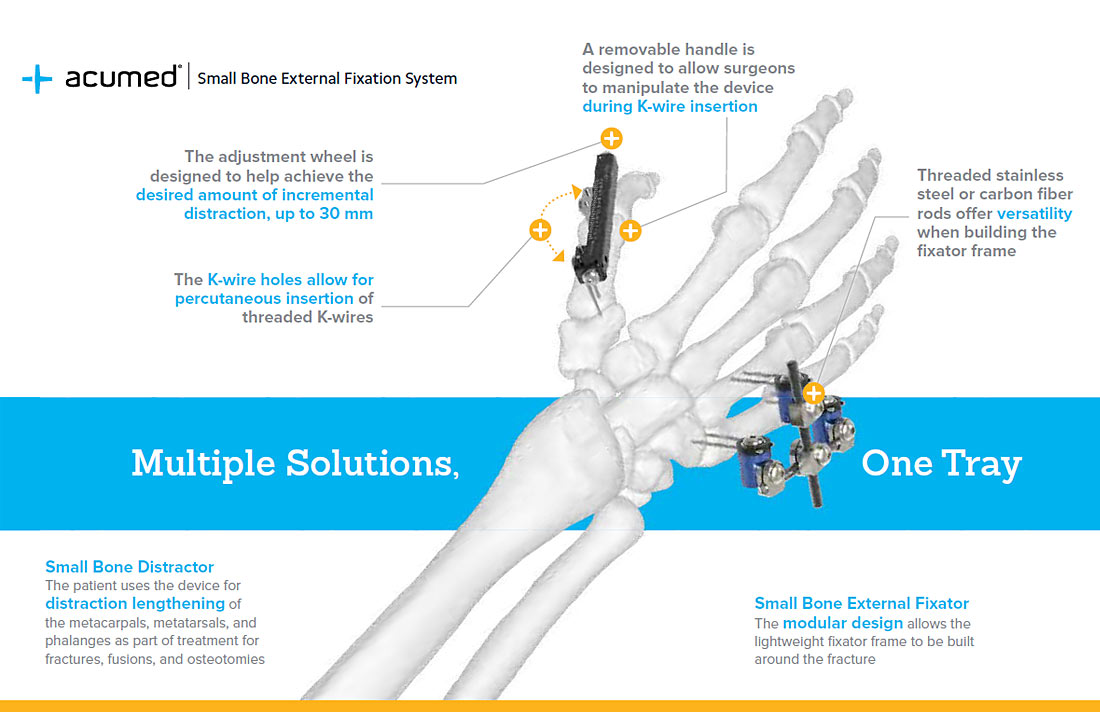
Acu-Loc® 2 Wrist Plating System
Evidence
Why This Matters
This study evaluates outcomes of intra-articular distal radius fractures with displaced dorsal lunate facet fragments treated with a combination of volar plating (Acu-Loc 2 VDR) and the use of a dorsal screw (Frag Loc Compression Screw) that integrates into the plate.
Publication Excerpt
Comprehensive Plating System
Standard, Variable Angle Locking, Fragment-Specific and Extension Plates address a variety of fracture patterns.
Fracture Support
Designed for subchondral support, the ulnar corner has 3 converging screws supporting the lunate facet and oers suture holes for addressing small volar fragments. Two diverging styloid screws target the radial column.
Frag-Loc® Technology
A patented, two-part cannulated compression screw is designed to compress dorsal fragments through a volar approach.
Instrumentation
Innovative instrumentation includes a targeting guide with radiopaque markings that allow visualization of anticipated screw trajectories. Kickstand posts are oered for distal first reduction and corrective osteotomy procedures.
Variety of Screw Options
2.3 mm Nonlocking, Locking, Smooth Peg, Variable Angle Locking, and Frag-Loc Compression Screws are oered for the distal end. The 2.7 mm and 3.5 mm Locking and Nonlocking Screws are oered for the shaft holes.

Acu-Loc® Wrist Spanning Plate
Evidence
Why This Matters
The Acu-Loc Wrist Spanning Plate provides temporary internal fixation for complex and/ or highly comminuted distal radius fractures.
Publication Excerpt
Temporary Internal Fixation for Comminuted Fractures
This temporary fixation device is designed to hold the wrist in distraction and to provide ligamentotaxis while the distal radius heals.
Plate Placement
Plates are designed to be placed over the second or third metacarpal.
Additional Fixation and Distraction
An optional distal radius screw cluster provides additional fixation, while a proximal slot allows additional distraction.
Precontoured Plate
The plate is precontoured with a dorsal bend of six degrees.
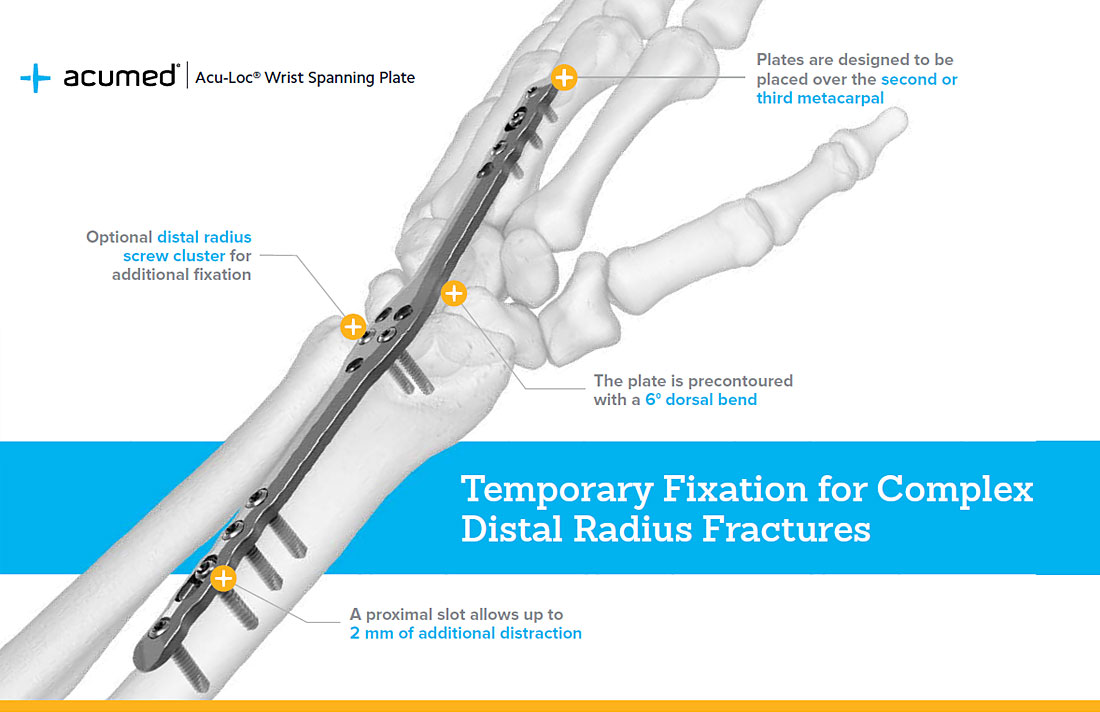
Arc Wrist Tower
Evidence
Why This Matters
Wrist arthroscopy plays a valuable role in the management of scapholunate instability. A spectrum of injuries can occur to the scapholunate interosseous ligament, which may be dicult to detect with imaging studies. Wrist arthroscopy enables detection and management of injury to the scapholunate ligament under bright light and magnified conditions, in both acute and chronic situations.
Publication Excerpt
For Wrist Arthroplasty and Fracture Reduction
Designed for the treatment of both soft tissue injuries and fractures of the wrist, the Arc Wrist Tower provides traction as well as unrestricted access during hand and wrist procedures.
Vertical Rotation
When vertical, the Arc Wrist Tower is designed to provide traction for wrist arthroscopy.
Horizontal Rotation
Provides access to the wrist during arthroscopic and fracturereduction processes.
Adjustable Wrist Joint
Allows the wrist to be placed in flexion or extension.
Surgical and C-arm Access
The support arm swivels 180 degrees around the patient’s forearm and elbow, facilitating fluoroscopic imaging from any angle.
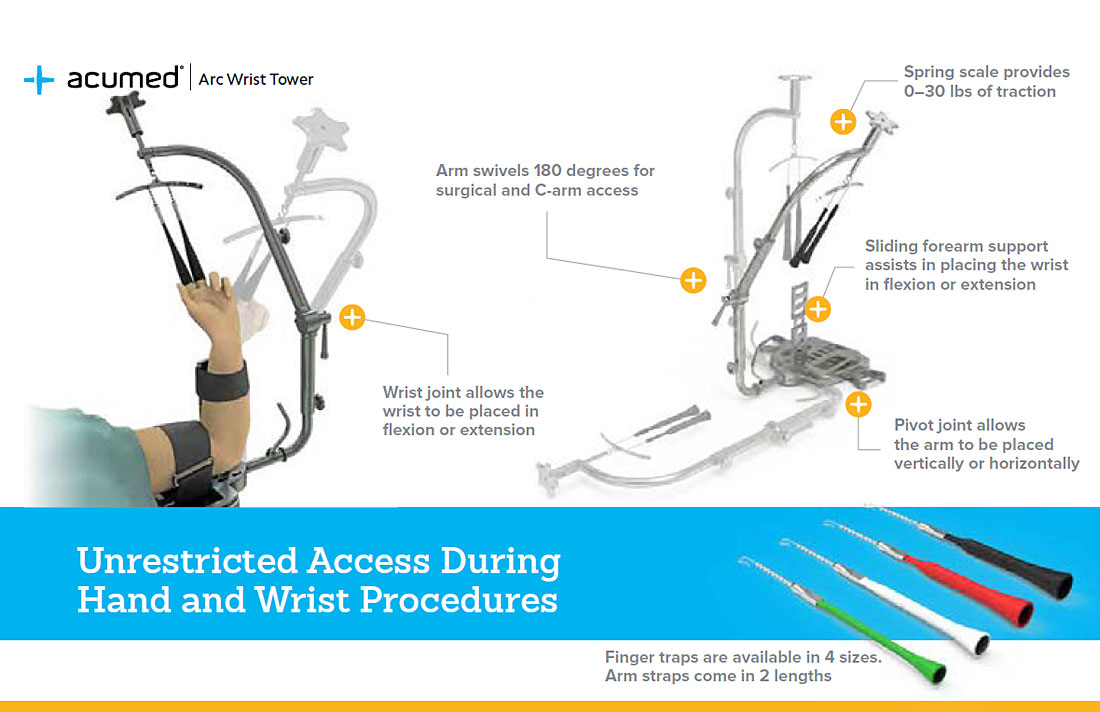
Total Wrist Fusion Plating System
Evidence
Why This Matters
Wrist arthrodesis significantly alters wrist function, but is an option for patients with unremitting wrist pain. Acumed’s Total Wrist Fusion plates place the wrist in 15 degrees of extension and 0–10 degrees of ulnar deviation, a position that is intended as a balance between anatomic resting position, hand function, and grip strength.
Publication Excerpt
“The number of operations performed prior to the wrist total fusion (seven of these being unsuccessful limited wrist fusion after treatment for scaphoid non-union) is interesting. It may be that total wrist fusion should be performed earlier for these problems rather than limited carpal arthrodesis, which will inevitably result in total arthrodesis at a later date.”
“Pryce (1980), in a very complete study, showed better grip strength both in 15° extension and 15° ulnar deviation, than in neutral in both planes.”
Approach-Specific Plate Options
The system oers left and right specific plates as well as a neutral plate. All plates have a 15-degree bend that is intended to maximize grip strength.1
Second Metacarpal
The system includes four plates designed specifically for second metacarpal placement to avoid tendon irritation.
Ulnar Deviation
Second metacarpal plate placement puts the wrist into ulnar deviation. This is intended to allow better grip strength.1
Converging Screw Design
The plates’ converging distal screw design is intended to assist with pullout resistance.
Neutral Plate Option
The Neutral Plate was designed to be used with a proximal row carpectomy.
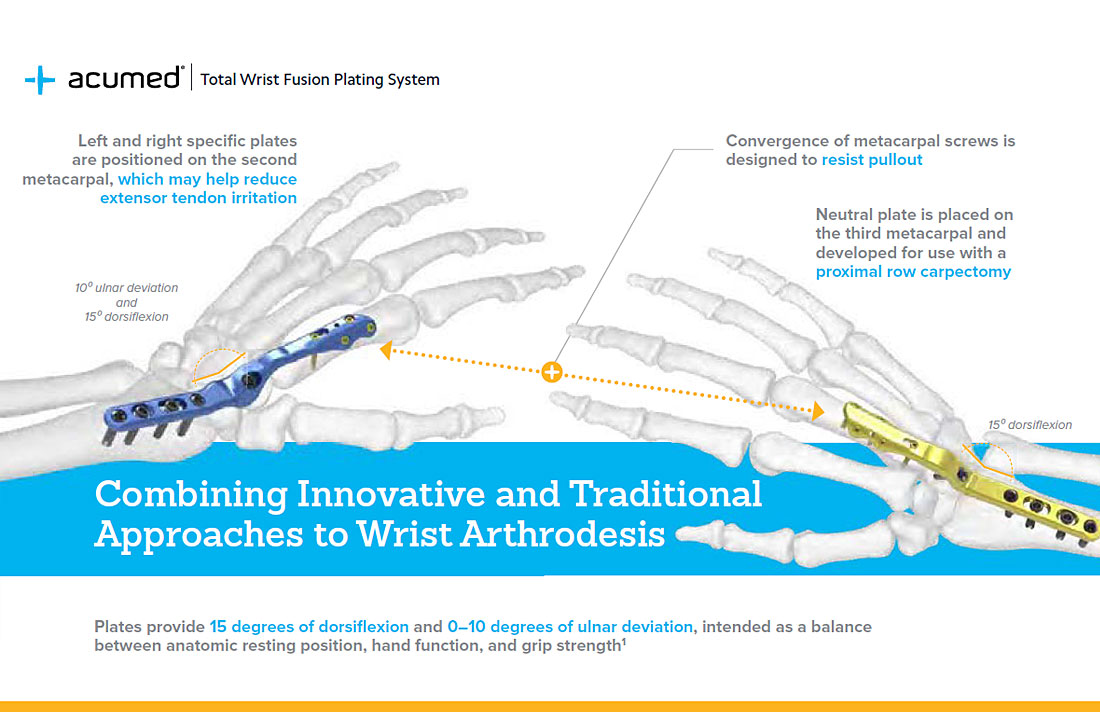
Anatomic Midshaft Forearm Plating System
Evidence
Why This Matters
The Anatomic Midshaft Forearm Plating System allows surgeons to restore the natural curvature of the proximal radius through the application of a precontoured plate. Restoration of native geometry is crucial to reestablishing patient range of motion and overall forearm pronation and supination.
Publication Excerpt
The First Precontoured Radius Plates
Due to the sagittal bow of the radius, plating with contoured plates in the sagittal plane improves rotation when compared with straight plates.1 For every 5 degrees of radial curvature that is not restored, the patient may lose 15 degrees of rotational motion.1
Three Plate Options
Acumed oers two contoured radius plate options, including volar and dorsolateral approach options and an ulna plate.
Precontoured Plate Advantages
Precontoured plates are intended to minimize the need for intraoperative plate bending to help save operating time. This allows surgeons to focus on restoring anatomy and re-establishing forearm pronation-supination.1
Creative Instrumentation
Innovative instrumentation includes a swiveling plate clamp, an angled drill guide, and a soft tissue spreader to aid in plate implantation. An oset drill guide enables dynamic compressive drilling for additional compression across the fracture site.

Ulna Rod
Evidence
Why This Matters
The advantages of an interlocking intramedullary nail system are that it is technically straightforward, it allows a high rate of osseous consolidation, and it requires less surgical exposure and operative time than plate osteosynthesis.
Publication Excerpt
Minimally Invasive
The rod is designed to be inserted through a small incision with minimal canal reaming.
Rotational Stability
The rod’s paddle-blade tip and interlocking screws are designed to lock and rotationally secure bone segments to assist in fracture union.
Straightforward Technique
The straightforward surgical technique is designed to streamline the surgical experience.
Precontoured Rods
Rods are precontoured to help match the ulnar canal’s geometry.
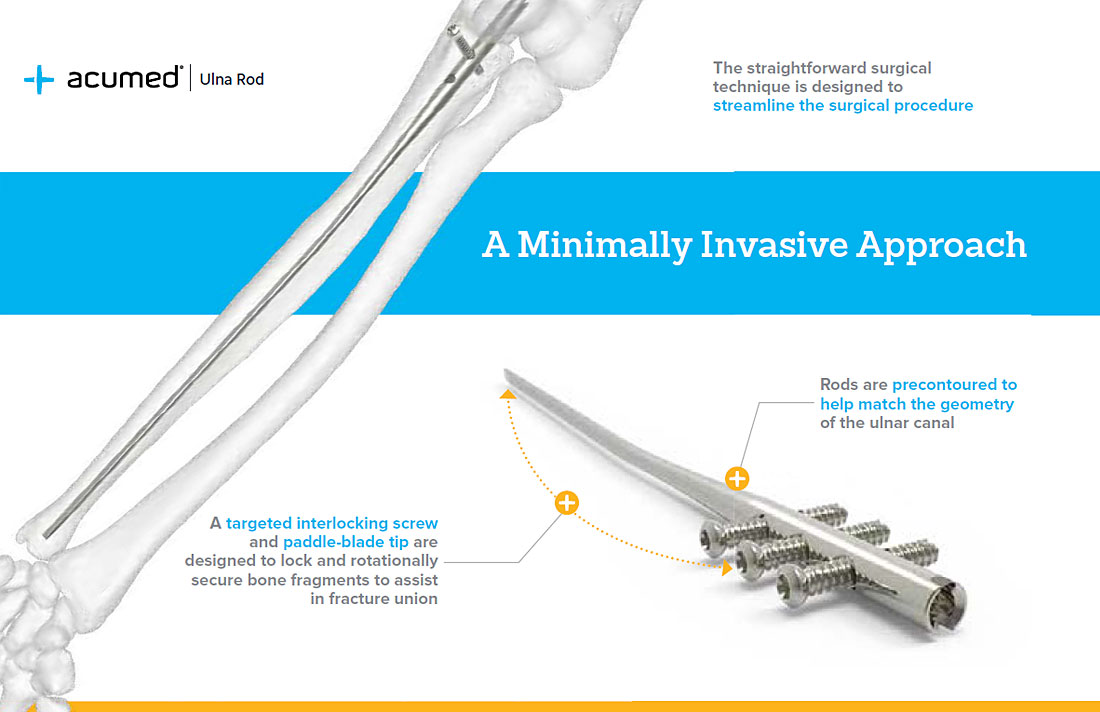
Osteotomy System
Evidence
Why This Matters
Ulna shortening osteotomies performed with Acumed’s system had a significantly lower hardware removal rate (3.3%) compared to transverse osteotomies (16.6%) and demonstrated a shorter duration for radiological healing.
Publication Excerpt
A Streamlined Approach
Featuring the industry’s first adjustable cutting guide, the Acumed Osteotomy system helped simplify the ulnar shortening osteotomy, by eliminating the need for numerous cutting jigs.
Osteotomy Compression
The reduction clamp’s speed-lock wheel is designed to help maintain hands-free compression, while the temporary reduction peg is engineered to stabilize the ulna during the osteotomy and assist with osteotomy compression.
Cutting Guide
The cutting guide oers continuous adjustment from 1 to 10 mm, allowing a resection of the amount desired.
Reference Lines
The reference lines on the Ulnar Shortening Plate spaced 2 mm apart, help facilitate the creation of the osteotomy when a “freehand cut” is preferred.
